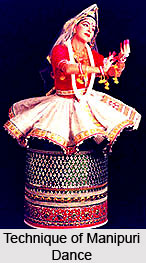Technique of Manipuri involves a unique treatment of different body parts. The unusual treatment of the body gives an impression of ease and fluidity. The vertical line of the body is followed always. There are no deflections or shifts from particular horizontal sutras. In fact, the body is curved into a figure of eight. This results in a position which is relaxed and controlled. Two parts of the body is connected through beautiful curves. There are no sudden transitions as such.
 With the posture that looks like an intertwined serpent it is not possible to spread out the lower limbs. The knees are kept close together which may be identified as the nata position of the knees in the Natyashastra tradition. The body is held upright and the torso is divided into two distinct parts above the katisvtra, the chest and the waist. Though the chest and the waist move in opposition they are always connected. This results in the curve slowly taking the shape of alphabet "S". The neck and the head follow this principle and the head executes a figure eight in space. The arms and hands follow the pattern of the lower limbs and the torso. They are held in a relaxed manner away from the body in a semi-circular curve. The wrists play an extremely important part in the movement of the hands and the fingers as the wrists give the movements of the fingers a unique flexibility. Gradual closing in and opening out of the fingers is a basic movement, while the wrist executes a figure of eight. The face is calm without any excess facial expressions. This expression is sustained throughout the performance.
With the posture that looks like an intertwined serpent it is not possible to spread out the lower limbs. The knees are kept close together which may be identified as the nata position of the knees in the Natyashastra tradition. The body is held upright and the torso is divided into two distinct parts above the katisvtra, the chest and the waist. Though the chest and the waist move in opposition they are always connected. This results in the curve slowly taking the shape of alphabet "S". The neck and the head follow this principle and the head executes a figure eight in space. The arms and hands follow the pattern of the lower limbs and the torso. They are held in a relaxed manner away from the body in a semi-circular curve. The wrists play an extremely important part in the movement of the hands and the fingers as the wrists give the movements of the fingers a unique flexibility. Gradual closing in and opening out of the fingers is a basic movement, while the wrist executes a figure of eight. The face is calm without any excess facial expressions. This expression is sustained throughout the performance.
The movements are feminine and may be described in the language of the Govinda Sangita Lila Vilas as the simitanga. Here the space is also limited and movement is also restricted. In the Lasya portions the dancer does not lift her foot away from the ground above the knee level. It is a gliding movement almost touching the floor. The situation changes in the Tandava portion. Here one has to be very alert and energetic and involves high leaps, whether executed by women in the role of the child Krishna or by men in the numerous male dances of the region.
There is a four tala distance between the two feet and the knees are bent in front. In the Tandava portions the torso is occasionally treated as a separate unit and there are frequent side-bends. In Lasya various positions attempts to limit space and although women dancers change the level throughout a performance, there is hardly much space between the two feet. In the Tandava portions the sthanakas form into vrischika Karanas of the Natyashastra tradition. There are few leg extensions in the Lasya or the Tandava portions. Neither in the Tandava portions nor in the Lasya portions are hip movements allowed. There is an up and down movement with the shift of weight from one foot to the other which is achieved through knee dips and through a suggestion of a hop on the toe.
The grace and delicacy of this dance can be understood from the manner of covering space. The dancer covers floor space in figures of eight and when the foot is lifted to cover space it invariably touches the ground by a slight toe movement. The kunchita foot of the Natyashastra is seen repeatedly in this dance style.




